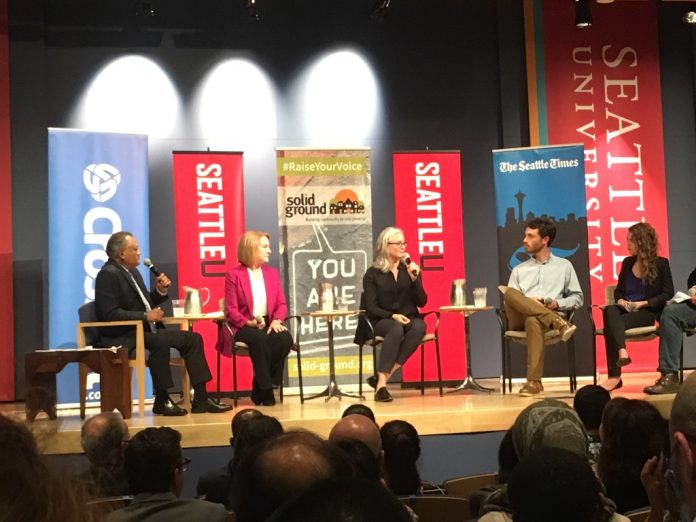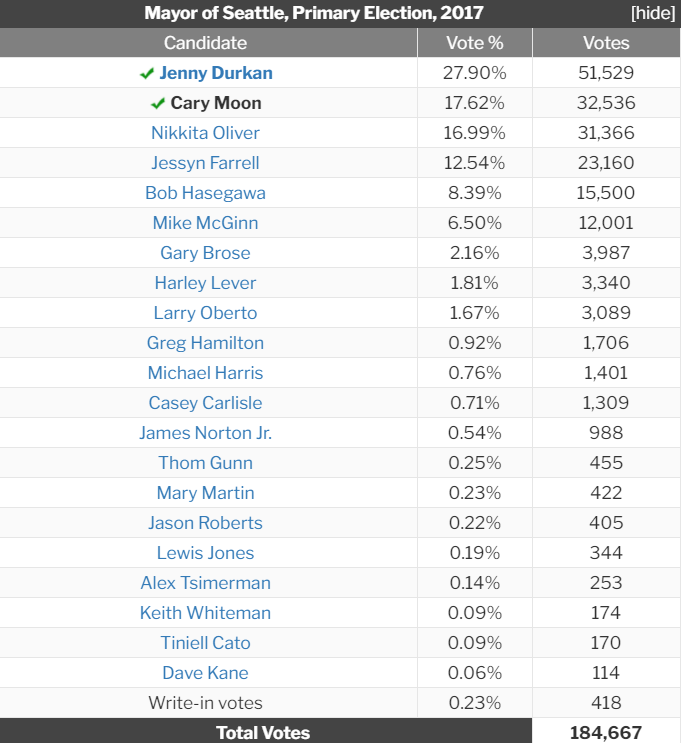Our top two advance primary is doing a disservice to voters, especially in crowded races.
With Seattle’s 2021 mayoral election looming and Mayor Jenny Durkan’s announcement she’s not running for reelection, the field could become quite crowded in the next few months. The 2017 election that also featured no incumbent. Durkan and Cary Moon ran in the general election, but before that we utilized a top two blanket primary to determine who would participate in that general election. In a rather crowded field, our system produced a result that advanced the winners of only 45.5% of the vote, sidelining the votes of a majority of 2017 primary voters.
Nikkita Oliver gained 17% of the vote, Jessyn Farrell 12.5%, Bob Hasegawa 8.4%, and Mike McGinn 6.5%. Fifteen candidates, including beef jerky baron Larry Oberto, split the remaining 10% of the primary vote. Second and third choice votes may have propelled a runner up into second place or even first. We’ll never know because our election system doesn’t ask.
The State’s top two primary system was approved by the people of Washington in 2004 to replace the short-lived partisan primaries. The vote came after Governor Gary Locke passed partisan primaries that lasted until 2008 when the Supreme Court reinstated a top two primary system, restoring our state’s historical blanket primary into its modern incarnation. This was an improvement from a system that limited voter participation with party identification, created spoiler vulnerable general elections, and increased election costs. While it can create general elections with majority winners, it’s clear that even with our current system the state can end up with races that don’t require the approval of a majority of the voters.
Currently, Washington state election law only allows local elections in this primary system. There is some movement to expand our voting options, and create more equitable and accessible election systems. Of particular relevance and potential realization has been ranked-choice voting. FairVote Washington is looking to allow ranked choice in Washington by way of a Local Options Bill, first examined by the state legislature in 2019. Ranked choice voting also made a recent appearance in the Seattle City Council, which on December 7th all councilmembers approved a 2021 state legislative agenda that mentioned support of the option.
The other ways we can conduct elections
So how does ranked choice work? Ranked choice allows voters to rank candidate options from most favored to least. Voters’ first choice votes are counted. If a winner or winners are unable to capture a majority of votes in the first round, votes can be transferred based on how the type of ranked choice system decides to eliminate or reallocate first choice votes and so on. In the Local Options Bill proposal, multiple iterations of ranked choice voting systems are outlined.
For single winner elections like the 2021 mayoral election will be, two new systems are presented. Both use an instant runoff voting method that has voters rank candidates, and in the first round counts first choice voters. If there is no majority winner then, a new round is conducted with the worst performing candidate eliminated and votes tabulated based on the highest ranking candidates available on ballots. If no majority winner is achieved this process is repeated until a majority is reached for a single candidate. The Local Options Bill from 2019 allows localities to either just have one round of voting and eliminate the primary, or keep two rounds of voting with the number candidates reduced to at least five for a general election.
More complicated is the system for multiple winner elections, potentially suitable for electing multiple citywide councilmembers. Local Options Bill would establish the option of single transferable vote, a system that has a calculated winning threshold based on the number of winners for the election. It uses instant runoff’s elimination of the worst performer, but first checks to see if there are surplus votes from candidates that have exceeded the winning threshold and then proportionally reallocates the excess. Rounds of tabulation are conducted until all the winners are produced. Scottish council elections use this method of voting, and their electoral commission has produced the following video.
These ranked choice systems always create scenarios where a majority of voters have their votes taken into account for determining the winner or winners. The method is already one of the most used voting systems in the world, having over a century of history of usage in Australia where it’s used in upper and lower house elections and some local races. In the US, Maine and Alaska recently adopted ranked choice.
An additional way to conduct elections is with approval voting, which allows for voters to vote for multiple candidates in a single race–choosing candidates that they would be fine with winning– and crowns whoever receives the greatest number of votes. This potentially chooses the candidate that the most number of voters would be content with. This option isn’t available in the Local Options Bill, but it’s still an interesting one to consider as it may produce a winner or winners with the widest support. This method was first coined in 1971, and was recently adopted in Fargo, North Dakota. History of use is sparse compared to ranked choice.
Mitigating gamification of our elections
Neither system eliminates the possibility of strategic voting and spoiler candidates to manipulate election results when more than two candidates are presented, but to be fair some literature indicates that all systems are vulnerable to gamesmanship. Instant runoff ranked choice can produce spoiler effects that may harm centrist candidates. Approval voting can incentivize voters to dishonestly select their approved candidates to give their favorite a better chance of winning, potentially devolving into a plurality vote system if voters refuse to vote for more than one candidate.
Nevertheless, both are an improvement over our currently implemented plurality vote systems that don’t give options to avoid a scenario of non-majority winners. The point of friction in our current system is the sole ability to choose one option, which can create unsatisfied strategic voters and marginalize challengers and third-party candidates. Having the ability to give more input than a single vote allows for the reduction of friction in that system and produces majority winners.
Multi-winner elections may be able to further reduce gamification, as it may cause voting dishonestly to be harmful to a voter’s interest. Multi-winner approval voting would disincentivize voting for candidates based primarily on electability, because your favorite longshot now also has the chance to win and your vote would not be ‘thrown away’ if they don’t. Single transferable vote ranked choice systems naturally reduces gamesmanship because excess votes could be proportionally distributed to help second favorites and so on, again producing a system where everyone’s interest is to honestly rank candidates.
Single transferable vote can also be manipulated to produce winners that capture a very substantial majority of voters. As a thought experiment, if the mayor was selected by the victors of a multi-winner election from their own peers then gamification of the mayor’s seat would be taken out of the voter’s hands and to an elected body that had mitigated some gamification already. Instead of a mayor, this would more so produce a prime councilmember and give the elected the risk of publicly gamifying the executive position. More citywide councilmembers and other changes might be needed to create a fair parliamentary system, but there are certainly quite a few interesting possibilities when single winner elections are eliminated to reduce gamification by voters.
Opportunity for more equity and democracy
Expanded options for voting in local elections gives cities the opportunity to examine and improve the equity and fairness in our elections. A single round of voting, as opposed to our existing two, could increase the accessibility of our elections by focusing all of voters’ and city election resources and attention to a single election and gallery of candidates. Ranked choice also doesn’t seem to affect turnout in a negative way, as one might think with the increased complexity of ranking choices versus just choosing one candidate. While the change happened before high profile elections in 2018 and 2020, Maine’s senate races didn’t see any dip in voter turnout after the state adopted ranked choice voting. While the sample size is still small, a paper out of the University of Missouri cautiously confirmed stable turnout before and after ranked choice adoption.
Another sore spot of Seattle democracy is the odd year voting for mayor that clearly left us depressed voter turnout. The 2017 mayoral general election got 49% voter turnout, and over 30,000 fewer voters participated in the primary than the general. For a city of more than 750,000 residents, 122,442 voted for Mayor Durkan, and 84,000 decided who would be in that general election. Shifting that election to an even year eventually may also help align our mayoral elections with major federal and state races when voter participation is highest. An odd year election restriction may also be on the legislative agenda of our state legislature.
In a discussion with Lisa Ayrault, director of FairVote Washington, she mentioned that a 2021 Local Options Bill may be packaged with an odd year election restriction, as pandemic disruptions have pushed committee chairs in the house to limit the number of bills introduced.
Our current system leaves much to be desired. We can do better for future elections if more options are legalized by our state government. If our state government can get ranked choice voting legislation passed in 2021, then we might just have the time to implement it for Seattle’s upcoming 2021 mayoral election. If you would like to see plurality voting tossed, be sure to let your state and local representatives know that you support expanded options of local elections.
Shaun Kuo is a junior editor at The Urbanist and a recent graduate from the UW Tacoma Master of Arts in Community Planning. He is a urban planner at the Puget Sound Regional Council and a Seattle native that has lived in Wallingford, Northgate, and Lake Forest Park. He enjoys exploring the city by bus and foot.




